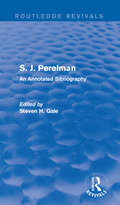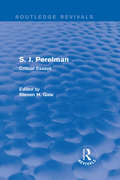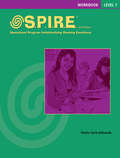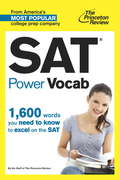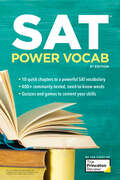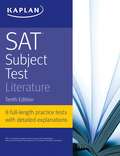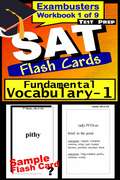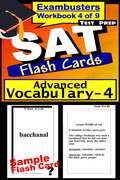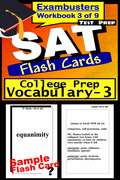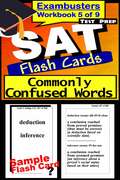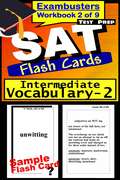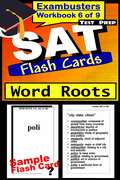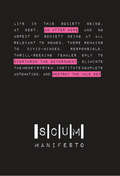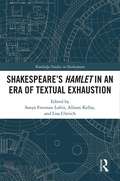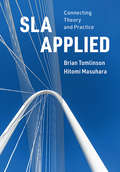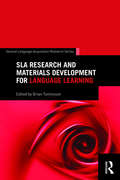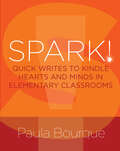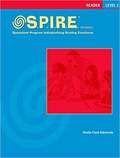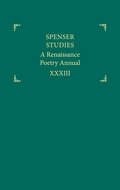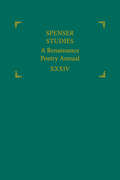- Table View
- List View
S. J. Perelman: An Annotated Bibliography (Routledge Revivals #Vol. 1274)
by Steven H. GaleFirst published in 1985, this bibliography focuses on the works of S. J. Perelman as a humorist, author, and screenwriter. It is divided into two major sections: "Works by S. J. Perelman" and "Critical Responses". Within each section, there are subdivisions which focus on various areas of S. J. Perelman’s work, including his novel, published plays and film scripts.
S. J. Perelman: Critical Essays (Routledge Revivals #Vol. 1274)
by Steven H. GaleFirst published in 1992, this book focuses on the oeuvre of S. J. Perelman. Taken together, the essays included serve as an introduction to this important humorist’s work, both in terms of the specific short prose pieces, plays, and films examined and as an overview of his lengthy professional career. They provide insightful and in-depth literary analyses as well. The work encourages a better appreciation for Perelman’s contributions to American literary history.
S.P.I.R.E. Level 5 (Third Edition)
by Sheila Clark-EdmandsThis S.P.I.R.E.® Level 3 (spire) decodable reader is perfect for early readers and those who need practice reading simple books with basic phonics concepts. This book includes words with suffix -ed (melted, smelled, winked).
S.P.I.R.E.: Workbook Level 7 (Specialized Program Individualizing Reading Excellence)
by Sheila Clark-EdmandsStudents can conquer their reading struggles once and for all with research-backed practices made just for them. This workbook covers all the key literacy concepts for S.P.I.R.E. Level 7 in one convenient place.
SAT Power Vocab
by Princeton ReviewTHE PRINCETON REVIEW GETS RESULTS! Ace the SAT verbal sections with 1,600+ words you need to know to excel. This eBook edition has been optimized for onscreen viewing with cross linked quiz questions, answers, and explanations.The Princeton Review's SAT Power Vocab brings you useful definitions and study tips for more than 1,600 frequently-used SAT words. It also includes strategies for memorizing the words and answering questions on the test, as well as a Final Exam section that tests your ability to apply your vocabulary knowledge to SAT questions.Inside the Book: All the Practice & Strategies You Need * More then 1,600 frequently-appearing vocabulary words from the SAT* 170 quizzes throughout the book to help you learn how to apply this knowledge* A Final Exam section with drills to test your grasp of vocabulary knowledge on practice SAT questions* An SAT "Hit Parade" of words most commonly tested on the actual exam
SAT Power Vocab, 2nd Edition: A Complete Guide to Vocabulary Skills and Strategies for the SAT
by Princeton ReviewTHE PRINCETON REVIEW GETS RESULTS! Tackle the test with confidence with a complete guide to vocabulary skills and strategies for the SAT. Prepping for the SAT may no longer mean memorizing long word lists, but a strong vocabulary is still essential to scoring well on the exam! SAT Power Vocab give you practical advice for understanding and remembering key vocabulary terms for both the Evidence-Based Reading & Writing and Math sections. Techniques That Actually Work.• Tried-and-true tactics to help you learn and remember key vocabulary• Straightforward advice on how to focus your vocabulary prep for the SAT• Handy memory aids for visual learners Practice Your Way to Excellence.• Lists of key vocabulary words defined in every chapter, along with example sentences• Practice exercises to help you master word roots, mnemonic devices, relationships between words, and more• Puzzles and other engaging activities to build and expand your word skills.
SAT Power Vocab, 3rd Edition: A Complete Guide to Vocabulary Skills and Strategies for the SAT (College Test Preparation)
by The Princeton ReviewTHE PRINCETON REVIEW GETS RESULTS! Tackle the test with confidence with a complete guide to vocabulary skills and strategies for the SAT. Prepping for the SAT may no longer mean memorizing long word lists, but a strong vocabulary is still essential to scoring well on the exam! SAT Power Vocab gives you practical advice for understanding and remembering key vocabulary terms for both the Evidence-Based Reading & Writing and Math sections. Techniques That Actually Work• Tried-and-true tactics to help you learn and remember key vocabulary• Straightforward advice on how to focus your vocabulary prep for the SAT• Handy memory aids for visual learners Practice Your Way to Excellence• Lists of key vocabulary words defined in every chapter, along with example sentences• Practice exercises to help you master word roots, mnemonic devices, relationships between words, and more• Puzzles and other engaging activities to build and expand your word skills.
SAT Reading Comprehension Workbook: Advanced Practice Series, Volume 1
by The Editors at the ILEX PublicationsReading Comprehension is one of the toughest aspects of the SAT*, even for the most advanced students. Time pressure, distractions, obscure passages and challenging vocabulary are overwhelming factors that make the reading comprehension section notoriously daunting. It doesn’t have to be this way. We at Integrated Educational Services (IES) have developed a user-friendly, time-saving technique that allows you to break down and master the Reading Comprehension section. And why should you trust this technique? Because IES has spent 14 years teaching some of the most advanced and highly motivated students from around the globe. For 14 years, we have helped these students reach their goal scores. We know that practice makes perfect. In this book, find 40 carefully crafted long reading comprehension passages and the accompanying questions, finely tuned to the specifications and difficulty levels of the real SAT*. We have also included a FREE online SAT* vocabulary course. Read it and reap: Learn from it, use it, and gain the confidence of knowing you have an edge over everyone else. Good luck with the SAT*!
SAT Subject Test Literature
by KaplanEssential strategies, practice, and review for SAT Subject Test Literature Getting into a top college has never been more difficult. Students need to distinguish themselves from the crowd, and scoring well on an SAT Subject Test gives students a competitive edge. Kaplan’s SAT Subject Test Literature is the most up-to-date guide on the market with complete coverage of both the content review and strategies students need for success on Test Day. Kaplan’s SAT Subject Test Literature includes: * 8 full-length Literature practice tests * A full-length diagnostic test * Focused chapter summaries, highlights, and quizzes * Detailed answer explanations * Proven score-raising strategiesKaplan is serious about raising students’ scores—we guarantee students will get a higher score, or get their money back.
SAT Test Prep 1 Flash Cards: Essential Vocabulary (Exambusters SAT Workbook #1 of 9)
by Ace Inc.<P><P><i>Advisory: Bookshare has learned that this book offers only partial accessibility. We have kept it in the collection because it is useful for some of our members. Benetech is actively working on projects to improve accessibility issues such as these.</i><P><P> "SAT Prep Flashcard Workbook 1: VOCABULARY-Fundamental" 300 basic words every high school freshman should know. Includes part of speech, pronunciation, succinct, easy-to-remember definition, and common synonyms and antonyms. If vocabulary isn't your strong suit, then review these common SAT words first. <P> EXAMBUSTERS SAT Prep Workbooks provide comprehensive, fundamental SAT review--one fact at a time--to prepare students to take practice SAT tests. Each SAT study guide focuses on one specific subject area covered on the SAT exam. From 300 to 600 questions and answers, each volume in the SAT series is a quick and easy, focused read. Reviewing SAT flash cards is the first step toward more confident SAT preparation and ultimately, higher SAT exam scores!
SAT Test Prep Flash Cards: Advanced Vocabulary (Exambusters SAT Workbook #4 of 9)
by Ace Inc.<P><P><i>Advisory: Bookshare has learned that this book offers only partial accessibility. We have kept it in the collection because it is useful for some of our members. Benetech is actively working on projects to improve accessibility issues such as these.</i><P><P> 350 words every well-educated person should know. While you may not hear them every day, they can show up on the SAT test, and understanding them will boost your score. <P><P>Includes sample sentence, part of speech, pronunciation, succinct, easy-to-remember definition, and common synonyms and antonyms. <P> EXAMBUSTERS SAT Prep Workbooks provide comprehensive, fundamental SAT review--one fact at a time--to prepare students to take practice SAT tests. Each SAT study guide focuses on one specific subject area covered on the SAT exam. From 300 to 600 questions and answers, each volume in the SAT series is a quick and easy, focused read. Reviewing SAT flash cards is the first step toward more confident SAT preparation and ultimately, higher SAT exam scores!
SAT Test Prep Flash Cards: College Prep Vocabulary (Exambusters SAT Workbook #3 of 9)
by Ace Inc.<P><P><i>Advisory: Bookshare has learned that this book offers only partial accessibility. We have kept it in the collection because it is useful for some of our members. Benetech is actively working on projects to improve accessibility issues such as these.</i><P><P> "SAT Prep Flashcard Workbook 3: COLLEGE PREP VOCABULARY" 350 frequently tested SAT words every college freshman should know. Perfect for anyone who wants to enrich their vocabulary! Improve your reading comprehension and conversation. Includes sample sentence, part of speech, pronunciation, succinct, easy-to-remember definition, and common synonyms and antonyms. <P> EXAMBUSTERS SAT Prep Workbooks provide comprehensive, fundamental SAT review--one fact at a time--to prepare students to take practice SAT tests. Each SAT study guide focuses on one specific subject area covered on the SAT exam. From 300 to 600 questions and answers, each volume in the SAT series is a quick and easy, focused read. Reviewing SAT flash cards is the first step toward more confident SAT preparation and ultimately, higher SAT exam scores!
SAT Test Prep Flash Cards: Commonly Confused Words (Exambusters SAT Workbook #5 of 9)
by Ace Inc.<P><P><i>Advisory: Bookshare has learned that this book offers only partial accessibility. We have kept it in the collection because it is useful for some of our members. Benetech is actively working on projects to improve accessibility issues such as these.</i><P><P> "SAT Prep Flashcard Workbook 5: WORDS COMMONLY CONFUSED" Do you know the difference between "fewer" and "less," when to use "it's" or "its," or how to distinguish between "historical" and "historic" or "tortuous" and "torturous?" This course contains 500 pairs of commonly confused words, some so frequently misused that their wrong application has become acceptable to many ears. Includes part of speech, pronunciation, simple definition, and usage example. Mastering the differences will improve your written grammar, verbal communication, and most importantly, your SAT test score! <P> EXAMBUSTERS SAT Prep Workbooks provide comprehensive, fundamental SAT review--one fact at a time--to prepare students to take practice SAT tests. Each SAT study guide focuses on one specific subject area covered on the SAT exam. From 300 to 600 questions and answers, each volume in the SAT series is a quick and easy, focused read. Reviewing SAT flash cards is the first step toward more confident SAT preparation and ultimately, higher SAT exam scores!
SAT Test Prep Flash Cards: Intermediate Vocabulary (Exambusters SAT Workbook #2 of 9)
by Ace Inc.<P><P><i>Advisory: Bookshare has learned that this book offers only partial accessibility. We have kept it in the collection because it is useful for some of our members. Benetech is actively working on projects to improve accessibility issues such as these.</i><P><P> "SAT Prep Flashcard Workbook 2: VOCABULARY-Intermediate" 500 frequently tested SAT words every high school student should know. Perfect for anyone who wants to enrich their vocabulary! Improve your reading comprehension and conversation. Includes sample sentence, part of speech, pronunciation, succinct, easy-to-remember definition, and common synonyms and antonyms. <P> EXAMBUSTERS SAT Prep Workbooks provide comprehensive, fundamental SAT review--one fact at a time--to prepare students to take practice SAT tests. Each SAT study guide focuses on one specific subject area covered on the SAT exam. From 300 to 600 questions and answers, each volume in the SAT series is a quick and easy, focused read. Reviewing SAT flash cards is the first step toward more confident SAT preparation and ultimately, higher SAT exam scores!
SAT Test Prep Flash Cards: Word Roots (Exambusters SAT Workbook #6 of 9)
by Ace Inc.<P><P><i>Advisory: Bookshare has learned that this book offers only partial accessibility. We have kept it in the collection because it is useful for some of our members. Benetech is actively working on projects to improve accessibility issues such as these.</i><P><P> "SAT Prep Flashcard Workbook 6: VOCABULARY WORD ROOTS" A unique collection of 380 essential Word Roots, Prefixes, and Suffixes, each with up to ten derivative word examples and definitions. Interpret new words without a dictionary. You'll view language from an entirely new perspective, and raise your SAT test score too! <P> EXAMBUSTERS SAT Prep Workbooks provide comprehensive, fundamental SAT review--one fact at a time--to prepare students to take practice SAT tests. Each SAT study guide focuses on one specific subject area covered on the SAT exam. From 300 to 600 questions and answers, each volume in the SAT series is a quick and easy, focused read. Reviewing SAT flash cards is the first step toward more confident SAT preparation and ultimately, higher SAT exam scores!
SCUM Manifesto
by Valerie SolanasFirst circulated on the streets of Greenwich Village in 1967, the SCUM Manifesto is a searing indictment of patriarchal culture in all its forms.<P><P> Shifting fluidly between the worlds of satire and straightforward critique, this no-holds-barred classic is a call to action-a radical feminist vision for a different world. This is an update of the essential AK Press edition, with a new foreword.Valerie Solanas was a radical feminist playwright and social propagandist who was arrested in 1968 after her attempted assassination of Andy Warhol. Deemed a paranoid schizophrenic by the state, Solanas was immortalized in the 1996 film I Shot Andy Warhol.
SHAKESPEARE’S HAMLET IN AN ERA OF TEXTUAL EXHAUSTION (Routledge Studies in Shakespeare)
by Sonya Freeman Loftis Allison Kellar Lisa Ulevich"Post-Hamlet: Shakespeare in an Era of Textual Exhaustion" examines how postmodern audiences continue to reengage with Hamlet in spite of our culture’s oversaturation with this most canonical of texts. Combining adaptation theory and performance theory with examinations of avant-garde performances and other unconventional appropriations of Shakespeare’s play, Post-Hamlet examines Shakespeare’s Hamlet as a central symbol of our era’s "textual exhaustion," an era in which the reader/viewer is bombarded by text—printed, digital, and otherwise. The essays in this edited collection, divided into four sections, focus on the radical employment of Hamlet as a cultural artifact that adaptors and readers use to depart from textual "authority" in, for instance, radical English-language performance, international film and stage performance, pop-culture and multi-media appropriation, and pedagogy.
SIKU: Knowing Our Ice
by Igor Krupnik Claudio Aporta Gita J. Laidler Lene Kielsen Holm Shari GearheardBy exploring indigenous people's knowledge and use of sea ice, the SIKU project has demonstrated the power of multiple perspectives and introduced a new field of interdisciplinary research, the study of social (socio-cultural) aspects of the natural world, or what we call the social life of sea ice. It incorporates local terminologies and classifications, place names, personal stories, teachings, safety rules, historic narratives, and explanations of the empirical and spiritual connections that people create with the natural world. In opening the social life of sea ice and the value of indigenous perspectives we make a novel contribution to IPY, to science, and to the public
SLA Applied: Connecting Theory and Practice
by Hitomi Masuhara Brian John TomlinsonThis singular new textbook is both an introduction to the major theories of second language acquisition and a practical proposal for their application to language learning courses. It explains and evaluates these theories, and focuses on recent research that has enriched thinking about the best ways to facilitate communicative effectiveness in an L2. It then suggests practical applications regarding language planning, curriculum development, pedagogy, materials development, teacher development, and assessment, establishing a tangible connection between theory and practice. Unlike many SLA books which are narrowly focused on the acquisition of language, it explores the roles of factors such as pragmatics, para-linguistic signals, gesture, semiotics, multi-modality, embodied language, and brain activity in L2 communication. SLA Applied connects research-based theories to the authors' and students' real-life experiences in the classroom, and stimulates reflection and creativity through the inclusion of Readers' Tasks in every chapter. This engaging and relevant text is suitable for students in Applied Linguistics or TESOL courses, trainee teachers, researchers, and practitioners.
SLA Research and Materials Development for Language Learning (Second Language Acquisition Research Series)
by Brian TomlinsonSLA Research and Materials Development for Language Learning is the only book available to focus on the interaction between second language acquisition theory and materials development for language learning. It consists of contributions written by experts in SLA, experts in materials development, researchers who have expertise in both fields, and introductions and conclusions by the editor. The book is organized into four major sections – position statements; materials driven by SLA theory; evaluations of materials in relation to SLA theory; and proposals for action – that offer a diverse range of perspectives while maintaining a cohesive and comprehensive overview on the subject. This book is ideal for post-graduate courses in applied linguistics and second language acquisition and for researchers interested in the relationship between SLA and materials development.
SPARK!: Quick Writes to Kindle Hearts and Minds in Elementary Classrooms
by Paula BourqueThe act of writing helps shape our thinking and is an important life skill we need to nurture in even our youngest students. In her new book, Spark!: Quick Writes to Kindle Hearts and Minds in Elementary Classrooms , author Paula Bourque recommends making writing a daily habit through enjoyable quick writes - short, frequent bursts of low-stakes writing that lets young students think and play with ideas on paper. Bourque believes that "quantity produces quality" and suggests writing exercises that can be infused throughout the day. In just 5-10 minutes each day, Spark! can boost student confidence and transform the way they think about themselves as writers. Build Skills and Stamina: By creating a daily writing habit, students can improve their writing, find their voice, and strengthen communication skills Spark Creativity: Low-stakes writing can reduce anxiety in students and encourage them to take risks, play with language, develop ideas, and write creatively. Packed with Prompts: Bourque includes a wide variety of quick write prompts, including visual, auditory, and verbal art that can stimulate thinking. Community of Writers: During the writing process, students become exposed to and can explore diverse thoughts and ideas of others Spark! offers purposeful and practical approaches that meet your students where they are in their writing development. Through volume writing, students can find their voice, build their language art skills, and gain confidence as a writer.
SPIRE Reader, Level 2
by Sheila Clark-EdmandsSPIRE Level 2 Reader 3/E. These interactive books are instructional. They provide plain text, without illustrations to help struggling readers focus and attend to the text. Inside you will find 100% decodable reading passages, word lists, and sentences for the application of decoding strategies, including marking up the text.
SPIRE Reader, Level 3
by Sheila Clark-EdmandsSPIRE Level 3 Reader 3/E. These interactive books are instructional. They provide plain text, without illustrations to help struggling readers focus and attend to the text.
SPS vol 33 num 1
by The University of Chicago PressSpenser Studies is devoted to the study of Edmund Spenser as well as the poetry of Renaissance England. Contributions examine Spenser’s place in literary history, the social and religious contexts of his writing, and the philosophical and conceptual problems he grapples with in his art. The journal also features work on Renaissance literary culture, broadly conceived. Past issues have published studies ranging from the diction of Stephen Hawes to female authorship in Mary Wroth’s Urania to the influence of English Renaissance sonneteers on William Butler Yeats.
SPS vol 34 num 1
by The University of Chicago PressSpenser Studies is devoted to the study of Edmund Spenser as well as the poetry of Renaissance England. Contributions examine Spenser’s place in literary history, the social and religious contexts of his writing, and the philosophical and conceptual problems he grapples with in his art. The journal also features work on Renaissance literary culture, broadly conceived. Past issues have published studies ranging from the diction of Stephen Hawes to female authorship in Mary Wroth’s Urania to the influence of English Renaissance sonneteers on William Butler Yeats.
